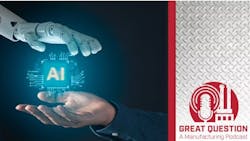Podcast: Can AI take over automation? What our editors witnessed at the big show
What you'll learn:
- AI adoption is surging, but real-world applications—not just hype—are key to proving its value on the factory floor.
- Simulation is evolving from concept to core tool, enabling better design and predictive maintenance in manufacturing.
- Integration speed and accessible automation now cater more to small- and midsize manufacturers, not just large operations.
- Open architectures and interoperability are breaking down silos, allowing seamless collaboration across industrial systems.
In this episode of Great Question: A Manufacturing Podcast, Robert Schoenberger, editor-in-chief of Smart Industry joined editors from SI sister publications: Mike Bacidore, chief editor of Control Design; Rehana Begg, chief editor of Machine Design; Sharon Spielman, technical editor for Machine Design; and Linda Wilson, chief editor of Vision Systems Design, share insights from the 2025 Automate show in Detroit.
See also: Manufacturers cite widespread labor shortages, use of automation and AI to help
The discussion centers on the widespread integration of AI in industrial automation, with a focus on practical applications and real-world uses. Topics include the growing role of simulation, increased accessibility of automation for small- to midsize manufacturers, and the importance of open system architectures. The conversation also highlights evolving industry partnerships and the push for greater interoperability across platforms.
Below is an edited excerpt from this podcast:
About the Podcast
Great Question: A Manufacturing Podcast offers news and information for the people who make, store, and move things and those who manage and maintain the facilities where that work gets done. Manufacturers from chemical producers to automakers to machine shops can listen for critical insights into the technologies, economic conditions, and best practices that can influence how to best run facilities to reach operational excellence.
Robert Schoenberger: We're all here in Detroit this week at Automate, the premiere show for automation and automation technologies. We've spent the past few days wandering around the show, looking at lots of robots and linear systems and all sorts of cool technology. What did you see that really interested you or was a surprise in any way? Let's start with you, Mike.
See also: How predictive AI can help manufacturers forecast demand for their products
Mike Bacidore: Sure. I mean, the obvious addition of AI to everything under the sun is so prevalent here at the show. There are a few interesting bits of technology. Even Beckhoff is kind of changing what used to be TwinCAT Chat.
They're rebranding that now—it's much more enhanced AI-assisted programming. I'm seeing a lot more AI-assisted programming, a lot more AI copilots that companies are designing into their software. Siemens had some interesting technology that they were showcasing for motion control.
RS: AI is everywhere. In some of these cases, it looks like, oh, these are brand-new AI systems—and it's so interesting and cool. In other cases, it’s like, you just threw two more letters onto last year's product, didn’t you? But there are some nice new examples of people doing interesting things.
See also: Firms see ‘smart’ manufacturing investments paying off in productivity, capacity gains
You mentioned Siemens. I was talking to someone over there, and they mentioned that, yeah, when you start talking about doing something like a large language model on industrial software, it’s a lot harder than when you’re dealing with, you know, whatever is on the Internet. Because you don't have a lot of technical diagrams out there. You're not going to have the ability to say, “What does a CAD file that does this look like?”—because that kind of information just isn't out there.
What is your company doing about cybersecurity?
So, they're struggling—not struggling—there's a real challenge in training these AIs on real industrial data, and they're just not going to get that in the public domain like you can with all these other things.
Rehana, you mentioned you had a few concepts and things that you saw that were interesting.
Podcast: Has additive peaked or is the marketplace for 3D manufacturing simply shifting?
Rehana Begg: What’s really interesting right now is that at this particular show, in 2025, NVIDIA was a keynote, which speaks volumes about how AI is being integrated. And their focus—their market focus—and the ability to bring what everyone was just teetering around with or tampering with—or, should I say, experimenting with—now really showing use cases, more so than ever before. So yes, AI everywhere, but can you prove it? Can you show me real applications?
I've seen some. Others, I don’t know. I don’t know that you're ready for prime time yet. But what did I like? Let’s see. So, I know NVIDIA has a partnership with Teradyne. So that’s UR and MiR.
RS: Universal Robots and Mobile Industrial Robots, for those of you who aren’t familiar with all those names.
RB: So, their collaboration is really tight. I’ve seen some interesting applications with what they have, including with large language models and large—I don’t know what it's called. You’ll be able to tell me, Linda—it’s the visual models that you can use. Just some interesting applications in physical environments.
And that’s—I said concepts, buzzwords—that’s the big one for this show: physically show me how you're actually applying artificial intelligence. Whether it's through—you name the AI—you pick it and then apply it in a physical environment, in a real environment, using robotics. That’s what I’m here to learn about.
See also: How manufacturers are closing high-skill gaps
And then the other concept that I think is really important here is simulation. Simulation has been around forever in different models, different styles—you know, physics models and digital twins.
Not hearing a lot about digital twins this time, but simulation is finally taking its place, I think, and being discussed in a way that takes the “digital twin” that everyone, about a year ago or two years ago, and even five years back, wanted to elevate. I’m not using that as a fuzzy term this time.
RS: It's interesting that you mention that, because I talked to a couple of different people who were talking about digital twins in relation to simulation—or in relation to AI.
The idea that you can take an existing digital twin and say, “Well, what happens if I do this?” And you simulate the data and then train your AI on things that haven’t happened yet.
It’s all very high-minded, but if you really start talking about it, you can work out planning scenarios. Like, what happens when this part fails right now in this kind of machine? How’s that going to ripple through our operations?
You get a sense of that and train the system to respond to something that hasn’t happened yet. It’s a fascinating idea. Who knows what will happen.
About the Author
Scott Achelpohl
Head of Content
I've come to Smart Industry after stints in business-to-business journalism covering U.S. trucking and transportation for FleetOwner, a sister website and magazine of SI’s at Endeavor Business Media, and branches of the U.S. military for Navy League of the United States. I'm a graduate of the University of Kansas and the William Allen White School of Journalism with many years of media experience inside and outside B2B journalism. I'm a wordsmith by nature, and I edit Smart Industry and report and write all kinds of news and interactive media on the digital transformation of manufacturing.

